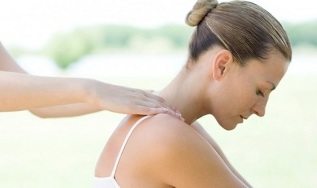
Spinal osteochondrosis is the most common disease of the human musculoskeletal system. In the cervical spine, degenerative processes develop especially often: in about 30-40% of all cases of osteochondrosis, the disease affects this particular area of the back.
Even with an inactive lifestyle, daily stress falls on the cervical area, leading to the gradual destruction of the cartilage tissue of the intervertebral discs. The cervical vertebrae support the head, provide lateral movement, and bend forward and backward. A sedentary lifestyle and excessive stress on the spine are also detrimental to the cartilage tissue.
Osteochondrosis develops slowly, but almost always leads to painful manifestations and serious consequences. This article will explain in detail how to treat cervical osteochondrosis at home, in what cases it is reasonable and desirable, what procedures should be performed to reduce pain symptoms and eliminate the main causes of the disease.
When can osteochondrosis be treated at home?
Osteochondrosis rarely occurs suddenly - usually the disease is preceded by an initial stage, characterized by fatigue in the back, rapid fatigue and decreased performance. It is important to take therapeutic measures at the first signs of the disease, while degenerative and dystrophic processes have not spread from cartilage tissues to neighboring structures.
The task of treatment at the initial stage of the disease is to stop pathological transformations in the intervertebral discs. No therapy can reverse destructive processes, but there is a chance to prevent dangerous and painful consequences.
You can do treatment at home in the following cases:

- When the diagnosis is precisely known and clinically confirmed;
- When the manifestations of the disease are mild or moderate;
- When home and self-treatment are approved or sanctioned by a physician;
- As relapse prevention during the recovery phase after full clinical treatment.
Clinical diagnosis and consultation with a specialist (orthopedist, vertebrologist or traumatologist) is a mandatory step in the treatment of osteochondrosis. Starting treatment without an accurate diagnosis can cause irreparable damage to the spine. Even if you are completely sure that you have osteochondrosis, you need to know its stage, determine the degree of tissue destruction and identify concomitant diseases.
The danger of cervical osteochondrosis lies in the variety of manifestations of this disease. Since the most important nerve pathways and blood vessels pass through this section, any displacement of the cartilage and bone structures from their anatomical position, as well as the transformation of the discs and vertebral bodies, leads to compression of the nerve endings and arteries. .
Compression causes headaches, deterioration of blood supply to the brain, and reduced intellectual capacity. The most dangerous complication of compression is stroke: a sharp deterioration in the supply of oxygen to the brain, leading to the death of its parts.
It is irresponsible and dangerous to treat cervical osteochondrosis at home with compression. Massage procedures, manual therapy, exercise therapy should be carried out under strict medical supervision. Only professional massage therapists and therapists should perform manual and material impact on the vertebrae in case of progressive degenerative changes.
General rules of self-therapy
Some people believe that cervical osteochondrosis is a temporary condition that occurs after sleeping in an awkward position or working at a computer for a long time. People often ignore the symptoms of neck pain, believing that they are caused by overworking, "salt deposits", colds.
The listed factors can really provoke the development of an attack of osteochondrosis, but they are not the causes, but the predisposing factors of the pathology. Removing them may alleviate the symptoms, but will not cure the disease itself.
The treatment of osteochondrosis should be approached in a scientific and pragmatic way. The earlier you start treatment, the more likely you are to restore the functionality of the cervical spine. If you want to regain mobility in your neck, get rid of crunches and back fatigue, start treatment immediately as soon as the first signs of degenerative changes appear.
Home treatment of osteochondrosis of the cervical area is a necessary and useful influencing measure if carried out correctly and authorized by specialists.
At home you can do:
- Drug therapy;
- Self-massage;
- Material massage using mechanical and electrical devices;
- Physiotherapy procedures;
- Physiotherapy.
Basically, any kind of conservative treatment can be done at home. Traditional methods of influence are popular among the population - a variety of lotions, compresses and applications on the affected department. These treatment options are sometimes quite effective and really help relieve the symptoms of pain and other unpleasant manifestations of osteochondrosis.
The basic rules for self-processing are as follows:
- Pain relievers and other medicines should only be taken after being prescribed by a doctor;
- You should not practice massage and physiotherapy exercises in case of acute pain and disc displacement;
- Questionable and unapproved traditional medicine should not be used;
- At the slightest sign of deterioration in health, you should stop the treatment at home and go to the clinic.
In general, experts even recommend self-treatment, since only procedures are performed in the clinic that require the presence of a specialist or the presence of complex equipment. It is enough to strictly respect the medical recommendations concerning the therapeutic techniques at home.
A good doctor, before recommending or prescribing any remedy, will always tell you how it is applied, what results should be expected, when and for how long you should carry out the treatment procedures. The ultimate goal of any practice is not only to stop the symptoms, but to block or completely eliminate the causes of the disease.
Home treatment methods
There are many home treatments available for cervical osteochondrosis. We will consider the most basic of them - the most efficient and the most affordable. We remind you once again: only the full implementation of medical recommendations gives a chance of recovery.
Qualified doctors take into account all influencing factors - from the position you take while sleeping to the nature of the diet. The diet for osteochondrosis is based on the exclusion of fatty, refined and over-seasoned foods and the mandatory inclusion of mucopolysaccharides in the diet - compounds that nourish cartilage tissue.
Almost all aspects of life must be brought into conformity with the principles of competent and correct treatment.
Physiotherapy exercises

A comprehensive regimen of physical activity is the basis of effective therapy. The set of exercises is selected individually, taking into account the stage of the disease, age and physical condition of the patient. Physical education is not an auxiliary, but the most important therapeutic method for osteochondrosis of the cervix region.
Gymnastic exercises solve several problems at once:
- Develop and strengthen the muscle corset in the neck and shoulder girdle;
- Stimulates local blood flow, improving nutrition of intervertebral discs and other tissues in the affected area;
- Accelerate metabolic processes, contributing to the restoration of physical activity;
- Eliminates muscle blockages and spasmodic phenomena.
At the initial stage of therapy, it is best to conduct several sessions of exercise therapy under the guidance of an experienced instructor. Then you can practice physical education at home. Make sure to wear comfortable clothes when exercising and make sure the area is ventilated regularly.
Criteria indicative of the usefulness of exercise therapy are freedom from pain, improved well-being, increased range of motion. If there are acute and regular pain symptoms, exercise should be stopped until the causes of this phenomenon are clarified. Pain usually occurs when the disc is moved and the nerve is compressed. To prevent this from happening, you need to perform the movements smoothly, avoid jumping and twisting the spine.
Manual and material massage
Self-massage reduces pain and stimulates local circulation. Self-massage techniques (rubbing, caressing, kneading) will be taught by your doctor or professional massage therapist. Strong pressure, shock, pinching should be avoided.
Proper self-massage often even surpasses drugs in effectiveness. Gentle manual effect not only relieves pain, but also relaxes muscles, accelerates blood circulation and metabolism. It is recommended to perform the massage in a sitting position, using only the fingers and directing the movements of the spine to the peripheral parts of the back.

A separate method is physical massage using modern mechanical and electronic devices. It is recommended to use massage products in the absence of severe pain and displacement of the discs. Inexpensive portable massagers and expensive computer-controlled devices are available at medical supply stores.
Applicators for static impact on affected areas are another effective tool. Devices such as the Lyapko applicator or the Kuznetsov applicator are proven and effective ways to treat the symptoms of pain and eliminate the causes of the disease. The main rule in the use of such devices is regularity. You need to practice exposure sessions constantly - only then is it possible to achieve a stable and pronounced health-improving result.
The applicators are based on the principles of reflexology - the impact on active parts of the body and the initiation of the body's self-healing mechanism. Home acupuncture with Lyapko devices and exposure of devices with Kuznetsov devices literally lifted some patients.
Other orthopedic aids are also useful - special pillows for sleeping, ensuring the correct position of the body at night, mattresses, car pillows and office chairs.
Physiotherapy at home
Exposure to a magnetic field, ultrasound, light of a certain spectrum - all of these methods are very effective in treating moderate and mild osteochondrosis. Physiotherapy is usually performed on an outpatient basis in clinics, but it is quite possible to use these methods at home.
Magnetotherapy, ultrasonic and electrical neurostimulation devices and other devices for the treatment of vertebral structures are sold in pharmacies and specialty stores. These devices eliminate pain, stimulate metabolism and blood circulation, and eliminate muscle spasms. These devices can only be used after being prescribed by a physiotherapist.
Compresses, rubbing, other traditional medicine procedures
The following alternative treatments are acceptable:
- Applications with healing clay;
- Compresses of honey, vodka, agave;
- Honey and mustard compresses;
- Propolis lotions, aloe juice and vodka;
- Treatment with bee venom;
- Rub with herbal preparations (the most popular option is a mixture of 2 scoops of chili with vegetable oil).
Plant-based preparations can be used in the absence of allergies and after approval of the method by a doctor.
Modern medicine offers many very effective and safe remedies on a natural basis to eliminate the signs of cervical osteochondrosis. Herbal creams, ointments and plasters of a combined composition are applied externally at the first manifestations of pain and at the stage of rehabilitation therapy.

























